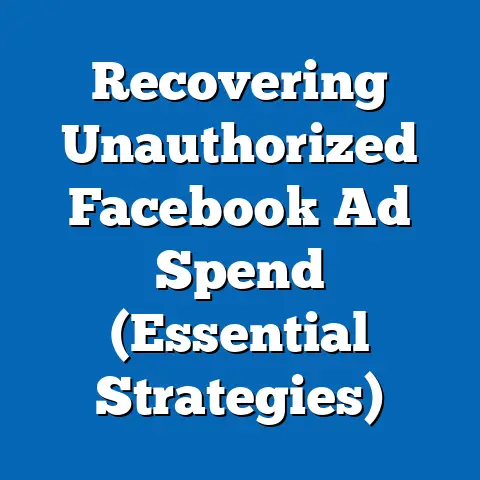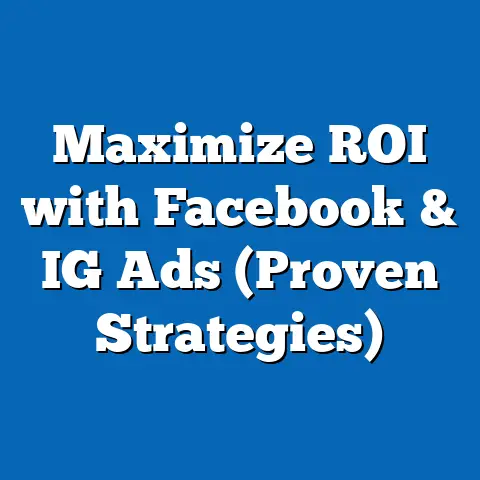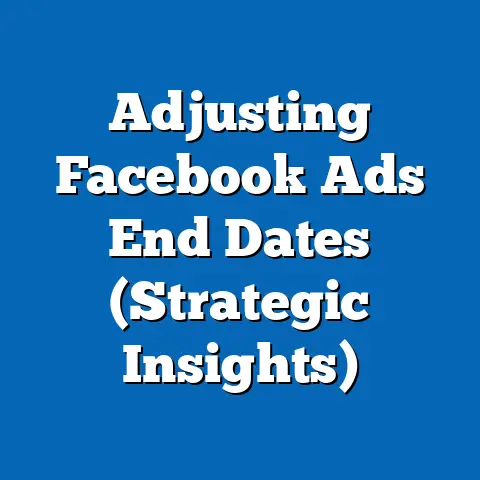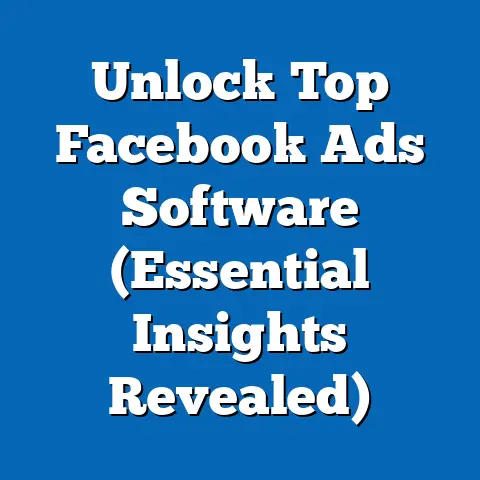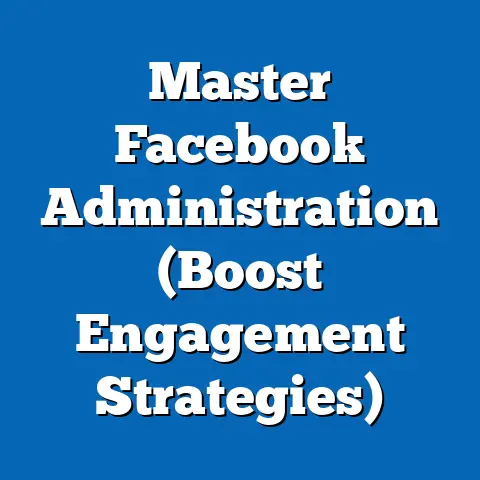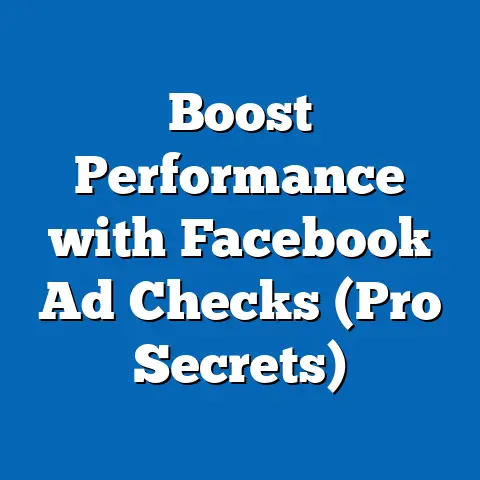Avoid 8 Costly Facebook Ad Mistakes (Expert Strategies)
8 Costly Facebook Ad Mistakes You Can’t Afford to Make: Expert Strategies to Maximize Your ROI
Facebook advertising offers an incredible opportunity for businesses to connect with a massive audience and drive meaningful results. With over 2.9 billion monthly active users, Facebook provides a platform to reach potential customers across various demographics, interests, and behaviors. However, simply launching a campaign isn’t enough. To truly succeed, you need to optimize your ad strategy and avoid common mistakes that can derail your efforts.
Unfortunately, I’ve seen countless businesses waste their ad budgets on ineffective campaigns due to easily avoidable errors. These mistakes range from neglecting audience targeting to ignoring ad format best practices. By understanding these pitfalls and implementing expert strategies, you can transform your Facebook advertising efforts and achieve significant ROI.
In this article, I’ll walk you through eight critical mistakes in Facebook advertising and provide actionable strategies to avoid them. Whether you’re a seasoned marketer or just starting, this guide will equip you with the knowledge and tools to optimize your campaigns and drive better results. Let’s get started!
Mistake #1: Neglecting Audience Targeting
One of the most common and costly mistakes I see is neglecting audience targeting. Many businesses launch campaigns with broad targeting parameters, hoping to reach as many people as possible. While this approach might seem logical, it often leads to wasted ad spend and poor results.
Why Precise Audience Targeting Matters
Precise audience targeting is crucial because it ensures your ads are shown to the people most likely to be interested in your products or services. By narrowing your focus, you can increase your ad relevance, improve engagement rates, and ultimately drive more conversions.
For example, imagine you’re selling high-end running shoes. If you target everyone on Facebook, your ads will be shown to people who have no interest in running, let alone expensive athletic footwear. This results in low click-through rates (CTR) and high costs per click (CPC).
Expert Strategies for Refining Audience Targeting
To avoid this mistake, I recommend using the following strategies:
-
Custom Audiences: Custom Audiences allow you to target people who have already interacted with your business. This can include website visitors, email subscribers, or customers who have purchased from you before. By targeting these warm leads, you can significantly increase your chances of conversion.
- Example: Upload your customer email list to create a Custom Audience. Then, target this audience with special offers or new product announcements.
-
Lookalike Audiences: Lookalike Audiences are based on your existing Custom Audiences. Facebook uses its algorithm to find users who share similar characteristics, interests, and behaviors with your best customers. This is a powerful way to expand your reach while maintaining a high level of relevance.
- Example: Create a Lookalike Audience based on your top 1% of customers. This will allow you to target users who are most likely to become high-value customers themselves.
-
Detailed Demographics, Interests, and Behaviors: Facebook provides a wealth of demographic, interest, and behavioral targeting options. Take the time to explore these options and refine your audience based on specific criteria.
- Example: If you’re selling organic baby food, target parents with young children who are interested in organic products and healthy living.
Custom Audiences: Custom Audiences allow you to target people who have already interacted with your business. This can include website visitors, email subscribers, or customers who have purchased from you before. By targeting these warm leads, you can significantly increase your chances of conversion.
- Example: Upload your customer email list to create a Custom Audience. Then, target this audience with special offers or new product announcements.
Lookalike Audiences: Lookalike Audiences are based on your existing Custom Audiences. Facebook uses its algorithm to find users who share similar characteristics, interests, and behaviors with your best customers. This is a powerful way to expand your reach while maintaining a high level of relevance.
- Example: Create a Lookalike Audience based on your top 1% of customers. This will allow you to target users who are most likely to become high-value customers themselves.
Detailed Demographics, Interests, and Behaviors: Facebook provides a wealth of demographic, interest, and behavioral targeting options. Take the time to explore these options and refine your audience based on specific criteria.
- Example: If you’re selling organic baby food, target parents with young children who are interested in organic products and healthy living.
Takeaway
Neglecting audience targeting is a costly mistake that can drain your ad budget. By using Custom Audiences, Lookalike Audiences, and detailed targeting options, you can ensure your ads are shown to the right people, increasing your chances of success.
Mistake #2: Ignoring Ad Format Best Practices
Facebook offers a variety of ad formats, each with its unique strengths and advantages. Ignoring ad format best practices can lead to ineffective campaigns and missed opportunities.
Understanding Different Ad Formats
Here’s a brief overview of some popular ad formats:
- Image Ads: Simple and effective, image ads are great for showcasing products or services with a single, compelling visual.
- Video Ads: Video ads are highly engaging and can be used to tell stories, demonstrate products, or share testimonials.
- Carousel Ads: Carousel ads allow you to display multiple images or videos in a single ad unit, each with its own headline, description, and link.
- Collection Ads: Collection ads are designed for e-commerce businesses, allowing users to browse and purchase products directly from the ad.
- Instant Experience Ads: Instant Experience ads (formerly known as Canvas ads) provide a full-screen, immersive experience that can include videos, images, and interactive elements.
Common Pitfalls
One common pitfall is using the wrong ad format for your campaign objective. For example, if you’re trying to generate leads, a simple image ad might not be as effective as a lead generation ad with a built-in form.
Another mistake is using low-quality or irrelevant visuals. Your ad creative should be visually appealing and directly related to your product or service.
Expert Tips for Selecting the Right Ad Format
To choose the most effective ad format, consider the following:
- Campaign Objective: What are you trying to achieve with your ad campaign? Are you trying to drive traffic to your website, generate leads, or increase sales? Choose an ad format that aligns with your specific goal.
- Target Audience: What type of content does your target audience prefer? Do they respond better to images, videos, or interactive experiences? Tailor your ad format to their preferences.
- Product or Service: What are you selling? Is it a visually appealing product that can be showcased in an image or video? Or is it a complex service that requires more detailed explanation? Choose an ad format that best represents your product or service.
Takeaway
Ad formats matter! Don’t just stick to one type of ad because you’re comfortable with it. Experiment with different formats to see what resonates best with your audience and aligns with your campaign objectives.
Mistake #3: Poor Ad Copy and Creative
Your ad copy and creative are the first things potential customers see, so they need to be compelling and attention-grabbing. Poor ad copy and creative can lead to low engagement rates, wasted ad spend, and missed opportunities.
The Importance of Compelling Ad Copy and Visuals
Compelling ad copy and visuals are essential for capturing attention, conveying your message, and driving engagement. Your ad copy should be clear, concise, and persuasive, while your visuals should be high-quality and relevant.
I’ve seen ads with amazing targeting completely flop because the ad copy was bland and the visuals were uninspired. On the other hand, I’ve seen ads with decent targeting perform exceptionally well because the copy and creative were outstanding.
Common Mistakes
Common mistakes in ad copy include:
- Vague Messaging: Your ad copy should clearly communicate the value proposition of your product or service. Avoid vague or generic language that doesn’t resonate with your target audience.
- Lack of a Clear Call-to-Action: Your ad copy should include a clear call-to-action (CTA) that tells users what you want them to do. Examples include “Shop Now,” “Learn More,” or “Sign Up Today.”
- Grammatical Errors and Typos: Nothing undermines your credibility like grammatical errors and typos in your ad copy. Always proofread your ads before launching them.
Common mistakes in ad visuals include:
- Low-Quality Images: Use high-resolution images that are visually appealing and relevant to your product or service. Avoid blurry or pixelated images.
- Irrelevant Visuals: Your visuals should directly relate to your product or service. Avoid using generic stock photos that don’t resonate with your target audience.
- Cluttered Design: Keep your visuals clean and uncluttered. Avoid overcrowding your images with text or graphics.
Strategies for Crafting Attention-Grabbing Ads
To create compelling ad copy and visuals, consider the following strategies:
- Know Your Audience: Understand your target audience’s needs, wants, and pain points. Use this knowledge to craft ad copy and visuals that resonate with them.
- Highlight Benefits, Not Features: Focus on the benefits of your product or service, rather than just listing its features. Explain how your product or service can solve your audience’s problems or improve their lives.
- Use Strong Visuals: Invest in high-quality images or videos that showcase your product or service in the best possible light. Consider hiring a professional photographer or videographer to create stunning visuals.
- A/B Test Your Ads: Experiment with different ad copy and visuals to see what resonates best with your audience. Use A/B testing to optimize your ads for maximum engagement.
Takeaway
Don’t underestimate the power of compelling ad copy and visuals. Invest time and effort into crafting ads that capture attention, convey your message, and drive engagement.
Mistake #4: Neglecting A/B Testing
A/B testing, also known as split testing, is the process of comparing two versions of an ad to see which one performs better. Neglecting A/B testing is a major mistake that can prevent you from optimizing your ad performance and maximizing your ROI.
The Importance of A/B Testing
A/B testing allows you to make data-driven decisions about your ad campaigns. By testing different elements of your ads, you can identify what resonates best with your audience and optimize your ads for maximum engagement.
I’ve seen businesses make assumptions about what works best, only to discover that their assumptions were completely wrong. A/B testing helps you eliminate guesswork and make informed decisions based on real data.
What Elements Should You Test?
You can test a variety of elements in your ads, including:
- Headlines: Test different headlines to see which ones capture attention and drive clicks.
- Images: Test different images to see which ones resonate best with your audience.
- Descriptions: Test different descriptions to see which ones convey your message most effectively.
- Calls-to-Action: Test different CTAs to see which ones drive the most conversions.
- Targeting Options: Test different targeting options to see which ones reach the most relevant audience.
Strategies for Conducting Effective A/B Tests
To conduct effective A/B tests, follow these strategies:
- Test One Element at a Time: To accurately measure the impact of each element, test only one element at a time. For example, if you’re testing headlines, keep all other elements of the ad the same.
- Use a Large Enough Sample Size: To ensure your results are statistically significant, use a large enough sample size. Facebook recommends running your A/B tests for at least a week or until you’ve reached a minimum of 1,000 impressions.
- Track Your Results: Use Facebook Ads Manager to track your results and measure the performance of each ad variation. Pay attention to metrics such as CTR, CPC, and conversion rate.
- Implement Your Findings: Once you’ve identified a winning ad variation, implement your findings and scale your campaign accordingly.
Takeaway
A/B testing is essential for optimizing your ad performance and maximizing your ROI. Don’t make assumptions about what works best. Test different elements of your ads to see what resonates best with your audience.
Mistake #5: Overlooking Tracking and Analytics
Tracking and analytics are crucial for measuring the success of your ad campaigns and making data-driven decisions. Overlooking tracking and analytics is a major mistake that can prevent you from optimizing your ad performance and achieving your goals.
The Role of Facebook Ads Manager
Facebook Ads Manager provides a wealth of data and insights about your ad campaigns. You can use Ads Manager to track your ad performance, measure your ROI, and identify areas for improvement.
I’ve seen businesses launch ad campaigns without setting up proper tracking, only to realize they have no idea how their ads are performing. This is like driving a car without a speedometer – you have no idea how fast you’re going or whether you’re on the right track.
Common Mistakes
Common mistakes related to tracking and analytics include:
- Failing to Set Up Conversion Tracking: Conversion tracking allows you to measure the number of conversions (e.g., sales, leads, sign-ups) that result from your ad campaigns. Without conversion tracking, you have no way of knowing whether your ads are actually driving results.
- Not Analyzing Key Metrics: Facebook Ads Manager provides a variety of metrics, such as impressions, clicks, CTR, CPC, and conversion rate. It’s important to analyze these metrics regularly to identify trends and patterns in your ad performance.
- Ignoring Attribution: Attribution is the process of assigning credit for conversions to different touchpoints in the customer journey. Ignoring attribution can lead to inaccurate conclusions about which ads are driving results.
Expert Advice on Leveraging Analytics
To leverage analytics for continuous improvement, consider the following:
- Set Up Conversion Tracking: Use the Facebook Pixel to track conversions on your website. This will allow you to measure the ROI of your ad campaigns and optimize them for maximum performance.
- Analyze Key Metrics Regularly: Set aside time each week to analyze your ad performance metrics. Look for trends and patterns that can help you identify areas for improvement.
- Use Attribution Modeling: Use attribution modeling to understand the impact of different touchpoints on your conversions. This will help you optimize your ad campaigns for maximum ROI.
Takeaway
Tracking and analytics are essential for measuring the success of your ad campaigns and making data-driven decisions. Don’t launch ad campaigns without setting up proper tracking and analyzing key metrics regularly.
Mistake #6: Setting and Forgetting Ads
Setting and forgetting ads is a common mistake that can lead to wasted ad spend and poor results. Many businesses launch ad campaigns and then neglect them, assuming they will run effectively on their own.
The Dangers of Neglecting Ads
In reality, Facebook ad campaigns require regular monitoring and optimization. The Facebook algorithm is constantly changing, and what worked yesterday might not work today. If you set and forget your ads, you’re likely to see a decline in performance over time.
I’ve seen businesses lose significant amounts of money by setting and forgetting their ads. They launch a campaign, see some initial success, and then assume it will continue to perform well without any further attention. However, over time, their ad performance declines, and they end up wasting their ad budget.
Creating a Schedule for Reviewing Ads
To avoid this mistake, create a schedule for reviewing your ads regularly. I recommend reviewing your ads at least once a week, if not more often. During your review, pay attention to the following:
- Ad Performance Metrics: Analyze your ad performance metrics, such as impressions, clicks, CTR, CPC, and conversion rate. Look for trends and patterns that can help you identify areas for improvement.
- Audience Targeting: Review your audience targeting to ensure you’re still reaching the right people. Consider refining your targeting based on your ad performance data.
- Ad Copy and Creative: Review your ad copy and creative to ensure they’re still compelling and relevant. Consider testing new ad copy and visuals to see if you can improve your engagement rates.
- Bidding Strategy: Review your bidding strategy to ensure you’re still bidding effectively. Consider adjusting your bids based on your ad performance data.
Takeaway
Don’t set and forget your ads. Create a schedule for reviewing your ads regularly and making necessary adjustments based on your performance data.
Mistake #7: Ignoring Mobile Optimization
With the increasing number of users accessing Facebook via mobile devices, ignoring mobile optimization is a major mistake that can significantly impact your ad performance.
The Importance of Mobile Optimization
Mobile optimization ensures your ads are displayed correctly on mobile devices and provide a seamless user experience. If your ads are not optimized for mobile, they may load slowly, display poorly, or be difficult to interact with.
I’ve seen businesses create beautiful desktop ads that look terrible on mobile devices. This results in low engagement rates and wasted ad spend.
Common Issues
Common issues related to mobile optimization include:
- Slow Loading Times: Mobile users are impatient and expect pages to load quickly. If your ads take too long to load, users are likely to abandon them.
- Poorly Formatted Ads: Ads that are not formatted correctly for mobile screens can be difficult to read or interact with.
- Non-Mobile-Friendly Landing Pages: If you’re driving traffic to a landing page, make sure it’s mobile-friendly. A non-mobile-friendly landing page can lead to high bounce rates and low conversion rates.
Tips for Ensuring Ads Are Mobile-Friendly
To ensure your ads are mobile-friendly, consider the following tips:
- Use Mobile-Friendly Ad Formats: Facebook offers a variety of mobile-friendly ad formats, such as mobile video ads and Instant Experience ads.
- Optimize Your Images and Videos: Optimize your images and videos for mobile devices by compressing them and using the correct dimensions.
- Use a Mobile-Friendly Landing Page: If you’re driving traffic to a landing page, make sure it’s mobile-friendly. Use a responsive design that adapts to different screen sizes.
- Test Your Ads on Mobile Devices: Before launching your ad campaign, test your ads on mobile devices to ensure they look and function correctly.
Takeaway
Mobile optimization is essential for reaching your target audience and driving results. Don’t ignore mobile optimization – make sure your ads are mobile-friendly and provide a seamless user experience.
Mistake #8: Failing to Utilize Retargeting Strategies
Retargeting is the process of showing ads to people who have previously interacted with your business. Failing to utilize retargeting strategies is a major mistake that can prevent you from maximizing your ROI.
What is Retargeting?
Retargeting allows you to re-engage with potential customers who have shown interest in your products or services. This can include website visitors, email subscribers, or users who have interacted with your Facebook page.
I’ve seen businesses generate significant ROI by using retargeting strategies. By targeting users who have already shown interest in their business, they can increase their chances of conversion.
Setting Up Effective Retargeting Campaigns
To set up effective retargeting campaigns, consider the following strategies:
- Target Website Visitors: Use the Facebook Pixel to track website visitors and create a Custom Audience of people who have visited your website.
- Target Engagement Audiences: Create a Custom Audience of people who have interacted with your Facebook page, such as liking your page, commenting on your posts, or watching your videos.
- Use Dynamic Ads: Dynamic ads allow you to show users ads for the specific products or services they viewed on your website.
- Offer Special Promotions: Offer special promotions or discounts to users who have previously interacted with your business. This can incentivize them to make a purchase.
Takeaway
Retargeting is a powerful strategy for re-engaging with potential customers and maximizing your ROI. Don’t fail to utilize retargeting strategies – set up retargeting campaigns to target website visitors and engagement audiences.
Conclusion
Avoiding these eight costly mistakes is essential for maximizing your ROI and achieving your advertising goals. By focusing on precise audience targeting, ad format best practices, compelling ad copy and creative, A/B testing, tracking and analytics, regular ad monitoring, mobile optimization, and retargeting strategies, you can transform your Facebook advertising efforts and drive better results.
Remember, Facebook advertising is an ongoing process that requires continuous learning and optimization. Stay up-to-date with the latest trends and best practices, and don’t be afraid to experiment with new strategies.
Now, I encourage you to reassess your current Facebook ad strategies and take proactive steps towards optimization. Implement the expert strategies I’ve shared, and watch your advertising efforts soar! Don’t let these mistakes hold you back – take control of your campaigns and achieve the success you deserve.

